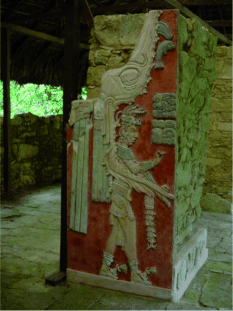Home > Press > Mayan Art in Yellow and Blue: Related to the famous Maya blue: Indigo compounds give Mayan art their yellow color
 |
Abstract:
For the Maya, blue was the color of the gods. For ritual purposes, art objects, and murals, they used Maya blue, a pigment without equal with regard to boldness, beauty, and durability. Maya blue is made of indigo embedded in a special clay mineral called palygorskite. A team led by Antonio Doménech at the University of Valencia (Spain) has now discovered that some Mayan yellow pigments are based on similar components. As the scientists report in the journal Angewandte Chemie, the Maya appear to have developed a preparative technique that was not limited to Maya blue and anticipated modern syntheses of organic-inorganic hybrid materials.
Mayan Art in Yellow and Blue: Related to the famous Maya blue: Indigo compounds give Mayan art their yellow color
Valencia, Spain | Posted on May 24th, 2011Maya blue is so fascinating because it has a special brightness and a singular color that can range from a bright turquoise to a dark greenish blue. Does the color stem from a unique organic component, a unique linking of the molecules, or a unique production process? Doménech and his team tested these hypotheses. They surmise that the hue is determined by the ratio of indigo to dehydroindigo, the oxidized form. This ratio depends on how long the Maya heated their formulation. This would allow for the formation of different variations of the addition compound formed by the indigo compounds and the mineral. The researchers further conjecture that the Maya were also able to produce yellow and green pigments from indigo-based pigments.
By means of various spectroscopic and microscopic methods, as well as voltammetry—a special electrochemical process that allows for the identification of pigments in micro- and nanoscale samples from works of art—the scientists examined a series of yellow samples from Mayan murals from different archaeological sites in the Yucatán (Mexico). The results confirm that a whole series of yellow pigments from Mayan mural paintings are made of indigoids bound to palygorskite. The researchers also found ochre.
Doménech and his co-workers think it very likely that the preparation of such "Maya yellow" pigments was an intermediate step in the preparation of indigo and Maya blue. Leaves and branches from indigo plants were probably soaked in a suspension of slaked lime in water and the coarse material filtered out. A portion of the yellow suspension could then be removed and added to palygorskite to make Maya yellow. The remaining suspension would then be stirred intensely and ventilated until it took on a blue color. It was then filtered and dried to obtain indigo for use as a dye. It could also be ground together with palygorskite and heated to produce Maya blue.
####
For more information, please click here
Contacts:
Antonio Doménech
Universitat de València (Spain)
Copyright © Wiley-VCH Verlag GmbH & Co. KGaA
If you have a comment, please Contact us.Issuers of news releases, not 7th Wave, Inc. or Nanotechnology Now, are solely responsible for the accuracy of the content.
| Related News Press |
News and information
![]() Researchers develop molecular qubits that communicate at telecom frequencies October 3rd, 2025
Researchers develop molecular qubits that communicate at telecom frequencies October 3rd, 2025
![]() Next-generation quantum communication October 3rd, 2025
Next-generation quantum communication October 3rd, 2025
![]() "Nanoreactor" cage uses visible light for catalytic and ultra-selective cross-cycloadditions October 3rd, 2025
"Nanoreactor" cage uses visible light for catalytic and ultra-selective cross-cycloadditions October 3rd, 2025
Discoveries
![]() Researchers develop molecular qubits that communicate at telecom frequencies October 3rd, 2025
Researchers develop molecular qubits that communicate at telecom frequencies October 3rd, 2025
![]() Next-generation quantum communication October 3rd, 2025
Next-generation quantum communication October 3rd, 2025
![]() "Nanoreactor" cage uses visible light for catalytic and ultra-selective cross-cycloadditions October 3rd, 2025
"Nanoreactor" cage uses visible light for catalytic and ultra-selective cross-cycloadditions October 3rd, 2025
Announcements
![]() Rice membrane extracts lithium from brines with greater speed, less waste October 3rd, 2025
Rice membrane extracts lithium from brines with greater speed, less waste October 3rd, 2025
![]() Researchers develop molecular qubits that communicate at telecom frequencies October 3rd, 2025
Researchers develop molecular qubits that communicate at telecom frequencies October 3rd, 2025
![]() Next-generation quantum communication October 3rd, 2025
Next-generation quantum communication October 3rd, 2025
![]() "Nanoreactor" cage uses visible light for catalytic and ultra-selective cross-cycloadditions October 3rd, 2025
"Nanoreactor" cage uses visible light for catalytic and ultra-selective cross-cycloadditions October 3rd, 2025
Human Interest/Art
![]() New 2D multifractal tools delve into Pollock's expressionism January 17th, 2025
New 2D multifractal tools delve into Pollock's expressionism January 17th, 2025
![]() Drawing data in nanometer scale September 30th, 2022
Drawing data in nanometer scale September 30th, 2022
![]() Scientists prepare for the world’s smallest race: Nanocar Race II March 18th, 2022
Scientists prepare for the world’s smallest race: Nanocar Race II March 18th, 2022
![]() Graphene nanotubes revolutionize touch screen use for prosthetic hands August 3rd, 2021
Graphene nanotubes revolutionize touch screen use for prosthetic hands August 3rd, 2021
|
|
||
|
|
||
| The latest news from around the world, FREE | ||
|
|
||
|
|
||
| Premium Products | ||
|
|
||
|
Only the news you want to read!
Learn More |
||
|
|
||
|
Full-service, expert consulting
Learn More |
||
|
|
||








